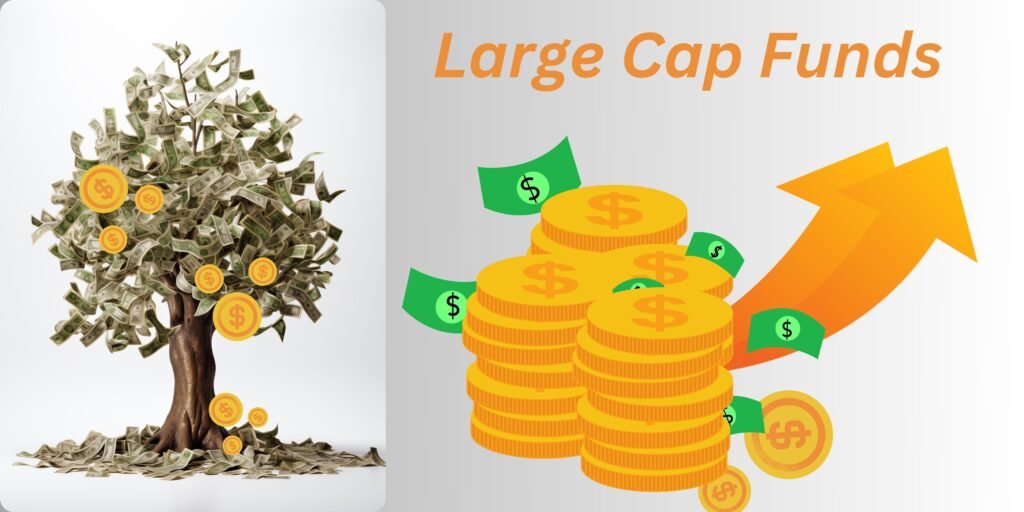Large-cap funds Investing in the stock market can be challenging, particularly given the abundance of possibilities. Of course! Mutual funds or exchange-traded funds (ETFs) that invest largely in the equities of large-capitalization corporations are referred to as large-cap funds. Generally speaking, large-cap firms are those that have a market capitalization of $10 billion or more—that is, the total value of their outstanding shares. If you’re looking for stability and reliable growth, large-cap funds might be your best bet. But what exactly are large-cap funds, and why should you consider them for your portfolio? Let’s dive deep into the world of large-cap funds and uncover everything you need to know.

What are large-cap funds?
There are several ways to increase your wealth through stock market investing, and large-cap funds are one of the most reliable and potentially profitable investment options. In this extensive guide, we will explore the definition of large-cap funds, their advantages, and how they fit into your investing plan.
Understanding Large-Cap Funds
Large-cap funds are mutual funds or exchange-traded funds (ETFs) that primarily invest in large-cap companies. These companies typically have a market capitalization of $10 billion or more. They are often well-established firms with a long history of stable earnings, substantial revenue, and significant market presence. Examples include giants like Apple, Microsoft, and Johnson & Johnson.
What is Market Capitalization?
Market capitalization, also referred to as “market cap,” is the total market value of the outstanding shares of stock in a company. The current share price multiplied by the total number of outstanding shares is how it is computed. According to their market capitalization, companies are typically divided into three groups:
- Large-Cap: $10 billion and above
- Mid-Cap: $2 billion to $10 billion
- Small-Cap: Under $2 billion
Large-cap funds are a preferred option for conservative investors since large-cap corporations are thought to be more stable and less volatile than their mid-cap and small-cap counterparts.
You can see all Large-cap and mid-cap COMPANIES LISTED
Advantages of Investing in Large-Cap Funds
Benefits of Putting Money Into Large-Cap Funds:
Dependability and Stability
The stability provided by large-cap funds is one of the main advantages of investing in them. Large-cap businesses often have a solid track record and are well-established, which can act as a buffer against market fluctuations. Because of this, investing in large-cap funds is safer, especially for those who are risk-averse.
Payment of Dividends
Big-cap firms frequently possess the financial stability necessary to regularly provide dividends. Regular dividend payments, which can add to the total return on investment and offer a consistent income stream, are advantageous to investors in large-cap funds. These companies often dominate their respective industries and continue to expand their market share, providing investors with sustained growth over time.
Potential for Long-Term Growth
Large-cap firms nonetheless provide significant chances for long-term growth, even though they might not have the same explosive growth potential as small-cap companies.
Liquidity:
Generally speaking, large-cap stocks are very liquid, making it easy to buy and sell them. For investors who might need to access their money fast or who want the freedom to adjust their investment portfolio without experiencing large price swings, this liquidity is useful.
Complications Associated with Large-Cap Funds
Market Risk
Large-cap funds are not immune to market risk, despite their steadiness. Global events, shifts in market sentiment, and economic downturns can all have an effect on large-cap stock performance and result in losses.
Low Potential for Growth
Large-cap firms offer stability, but their potential for growth may be less than that of smaller, more nimble businesses. To reach their investing objectives, investors hoping for greater returns would need to add mid-cap or small-cap funds to balance their portfolios.
sectoral Concentrate
Large-cap funds could be heavily exposed to particular industries, including healthcare or technology. A decline in these industries could have a detrimental effect on the fund’s overall performance.
How do Invest in large-cap Funds?
Selecting the Appropriate Fund
It’s important to take the fund’s track record, expense ratio, and management team’s experience into account when choosing a large-cap fund. Seek funds with affordable fees and a track record of outperforming their benchmarks.
The act of diversification
To control risk in any investing portfolio, diversification is essential. Bonds and other asset classes, together with a combination of mid-cap and small-cap funds, can help form a diversified and well-balanced portfolio, even while large-cap funds offer stability.
Frequent Inspection
Investing is not something you do once and then forget about. You may make well-informed judgments and modify your investing plan as necessary by keeping a close eye on the performance of your large-cap funds and remaining up-to-date on changes in the market and economy.
Top Large-Cap Funds to Consider
VFINX, the Vanguard 500 Index Fund
One of the most well-known large-cap funds, the Vanguard 500 Index Fund follows the S&P 500 Index’s performance. It provides wide exposure to the U.S. market with a diversified portfolio of large-cap equities and a low expense ratio.
FCNTX, or Fidelity Contrafund
The active-managed Fidelity Contrafund is concentrated on large-cap growth equities. It has a proven track record of outperforming the market and is run by seasoned fund managers who look for reputable businesses with promising future growth.
Blue Chip Growth Fund T. Rowe Price (TRBCX)
The T. Rowe Price Blue Chip Growth Fund makes investments in reputable blue-chip businesses that have a track record of impressive success. It makes investments in businesses that are expected to provide long-term capital growth.
A well-rounded investment portfolio must include large-cap funds. They are a desirable choice for cautious investors because they provide stability, the possibility of steady growth, and consistent dividend payments.
Are large-cap funds high-risk?
Yes, because large-cap funds are more stable and have less volatility than mid-cap and small-cap funds, they are typically a good choice for risk-averse investors.
Which fund is best, large-cap or mid-cap?
Which large-cap or mid-cap fund is ideal for you will depend on your investing objectives and risk tolerance. Mid-cap funds offer stronger growth potential but come with increased volatility, making them suited for investors ready to take on more risk for possibly bigger profits. Large-cap funds offer stability and steady returns, making them excellent for cautious investors.
Which fund cap is best?
The ideal fund cap is determined by your personal investing objectives and level of risk tolerance. While mid-cap and small-cap funds provide greater growth potential but at a higher risk, large-cap funds are the best for stability and steady returns. Make a decision depending on your risk tolerance and financial goals.
What is a large-cap value fund?
An exchange-traded fund (ETF) or mutual fund that focuses on investing in large-cap firms that are deemed to be cheap in relation to their inherent worth is known as a large-cap value fund. Usually valued at $10 billion or more, these businesses are regarded as financially sound and have strong foundations. Large-cap value fund investors focus on businesses with solid balance sheets, consistent earnings, and the potential for stock price increases as the market realizes these companies’ true value to achieve stable growth with fewer risks.
Which is more risky, large-cap or mid-cap?
Mid-cap funds are generally more risky than large-cap funds. Large-cap companies are more established and financially stable, offering more consistent returns and lower volatility. Mid-cap companies, while offering higher growth potential, tend to experience greater price fluctuations and are more susceptible to economic changes, making them riskier investments.
If you have any queries or suggestions, you can tell me, guys…

